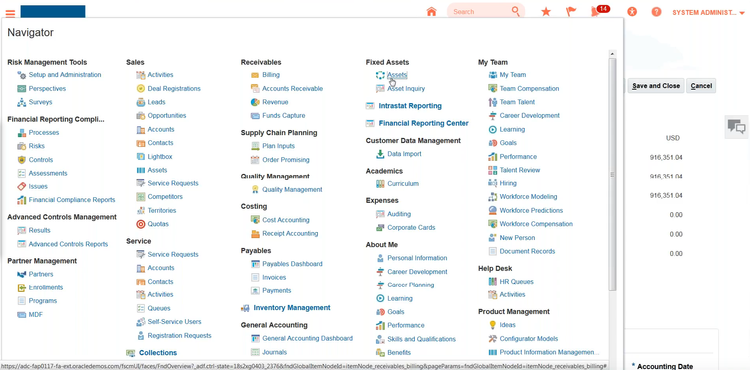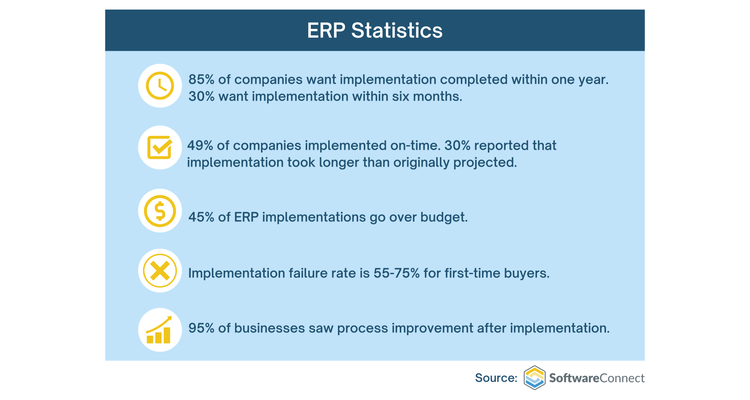How to Build an ERP Business Case
Building and implementing an effective ERP business case can be easy with the right guide. Learn how you can assess the benefits and potential risks of implementation. Free template included below.
An ERP business case is a proposal that assesses the benefits, timeline, and potential risks of implementing new ERP software.
It justifies the costs and resources involved with deploying a new system to key stakeholders. A business case also provides project governance and drives internal alignment within the organization.
Learn how to build a convincing proposal for adopting a new ERP system, and use our business case template to get started.
What Is the Importance of Building a Case?
ERP integrates vital business processes across a company, allowing marketing, accounting, project management, and CRM to talk to one another and present employees with a unified, real-time version of “the truth.”
An ERP business case goes beyond rationalizing expenses to stakeholders. It also serves as a project plan, defining objectives and KPIs to measure the new system’s progress and helping to identify any potential issues post-implementation.
Building this proposal might seem extraneous if you’ve already received approval to initiate a new ERP application. However, a business case keeps the entire digital transformation on track. In addition, it provides benchmarks even after the new system is in place.
Ultimately, you’re showing corporate decision-makers how a modern ERP system is crucial in executing your business strategy. Because the modules within an ERP platform “talk” with one another, your company’s communications, reporting, and processes will run more efficiently, boosting your bottom line.

Goals of a Business Case
Beyond providing a cost-benefit analysis of implementing new software, a business case also directs your ERP project. Here are the six objectives you will meet when building a proposal.
- Justify investment: We’ve discussed how a business case rationalizes investment in a new ERP system. However, it can also show alternative courses to implementing a new ERP, such as upgrading your current platform or reengineering your business processes.
- Better project governance: Your proposal outlines the business value your ERP system will bring to the organization. It specifies the process improvements you hope to put in place and keeps implementation on track. A business case also serves as a reference when potential changes to the plan arise. For example, a stakeholder may want to customize the software with a third-party feature. Project managers can check the business case to determine if that customization aligns with initial goals.
- Define metrics and KPIs: Maximize investment by setting KPIs to measure your progress. For instance, ERP software includes lead management, helping your company manage the sales pipeline. If the goal is to use ERP to strengthen customer relationship management and increase sales, you could measure the revenue generated by follow-up activities.
- Better alignment within the organization: A compelling proposal shows how a new ERP system supports organizational goals and the overall business strategy. It also justifies upheaval when adapting to a new system. It powers change management as employees rethink their roles and retrain on operations.
ERP Business Case Template
Use our business case template to take a structured approach to your ERP proposal. Present inadequacies within your current system, create a cost-benefit analysis, and calculate your ROI in a clear, concise document.
This template contains sections for the following:
- Executive summary
- Pain points in the current system
- Benefits and objectives
- Proposed solutions (features, pricing, implementation, ROI)
- Cost/benefit analysis
- Implementation timescale
- Risk assessment matrix and management plan
- Required resources
- Expected results
- Metrics and KPIs
- Request summary and approvals
You can download our free ERP business case template here.
7 Steps to Building an ERP Business Case
To write a compelling ERP business case, you can approach the potential advantages and disadvantages of implementation from multiple angles. Here are seven critical steps for drafting an effective proposal.
Assess pain points in the current system: Identify and gather data on the issues in your existing system. For example, you could quantify losses due to data silos and inefficient communication. Maybe your sales department over-promises orders that production cannot fulfill. Because an ERP system integrates these different operations, you could eliminate losses by deploying a new platform.
Determine the benefits of a new ERP solution: Pinpoint specific advantages to upgrading your ERP; consider potential cost reductions like eliminating support fees for customizations or finding a new platform with lower licensing costs. Show how a new application will positively affect revenue and sales growth and capture intangible benefits like enhanced customer satisfaction.
Evaluate available ERP solutions: Consider implementation time and costs, deployment options, training and support resources, and the functional fit of ERP software to your specific industry and organizational goals. For example, a manufacturing company would choose a platform with manufacturing ERP features like scheduling, shop floor control, and quality management.
Estimate project costs: Expenses include implementation and licensing fees, ongoing maintenance costs, data migration, training, and any hardware or software upgrades required to run the core ERP application. Rather than relying solely on ERP vendors for the total cost of ownership, research expenses unique to organizations like yours for the complete picture.
Calculate return on investment: Analyze tangible and intangible benefits and contrast these with projected costs. Tangible benefits include reduced costs and increased revenue. Intangible benefits include improved organizational processes and better customer experience.
You can use the following formula to determine the ROI ratio:
(total value of investment - total cost of ownership / total cost of ownership) x 100.
The higher the ratio, the better your ROI will be.
For example, you’ve determined that a new ERP will reduce the need for labor hours dedicated to checking for manual data entry errors. It will also increase touchpoints between customers and sales agents, increasing revenue. Altogether, the 5-year value the ERP will bring to your company is an estimated $1,000,000. The 5-year investment is $500,000.
($1,000,000 - $500,000 / $500,000) x 100 = 100%.
Implementation of this new system represents a 100% ROI.
Consider the risks: Assess liabilities like project delays, incompatible ERP and company workflows, cost overruns, and implementation failure. Utilize a prioritization framework like a risk assessment matrix to rank liabilities based on their impact. Using this matrix, develop a risk management plan to help mitigate those potential risks.
Create and present a high-level implementation plan: An ERP implementation plan should include your risk management plan, a broad deployment timeline, a list of required resources, and expected results for the top decision-makers in your organization. This will require an understanding of individual stakeholders’ concerns and expectations. Address these questions at a high level and clearly explain how you will measure progress during implementation.
Set measurable objectives and KPIs to assess your business’s progress post-implementation. On average, successful implementations take 4-6 months but can take longer depending on company size, project scope, and required customizations. Communicate consistently with senior management and team members to ensure stakeholder buy-in throughout this process.
How to Convince Stakeholders
Stakeholders need evidence that the benefits of your new ERP software will outweigh the risks and expenses associated with the change. Here are some ways to get critical decision-makers on your side.
- Understand each stakeholder’s values and concerns: Tailor your data to each individual’s agenda. For example, a CEO will likely focus on the overall financial impact of a new ERP application. At the same time, a CMO will want to see how the software powers their marketing and advertising strategy.
- Anticipate their questions and prepare answers backed by hard data: Come prepared to answer common objections like “a cloud ERP system will open us up to data breaches” or “our existing ERP works just fine — we don’t have time to implement new software.” Conduct research and provide hard data to challenge these assumptions. For example, you could show how the probability of system failure increases over time when using outdated technologies.
- Express a sense of urgency to address change resistance: It’s natural for executives to want to postpone the disruption ERP implementation can bring to employees and operations. Show how postponement can negatively impact sustainability and growth, increase reputation risk, and ultimately delay the overall savings ERP provides in the long term. Curtail change resistance by recommending ways to prepare employees and adapt current business processes to ERP workflows.
- Give realistic expectations about implementation and user training: Be upfront about implementation expenses and time frames. Let stakeholders know when the company will likely recoup costs and start seeing a return on investment to avoid pulling the plug on your new ERP application entirely. Factor in your company’s size, required customizations, and project scope when estimating costs and timelines. Also include success factors like employee onboarding and organizational change management.
- Tailor the Rollout Strategy - The chosen implementation strategy can make or break stakeholder buy-in. Some groups will appreciate the reduced risk of a phased rollout, while others may value the speed of a big-bang launch, or the controlled testing of a pilot project. Framing your implementation plan around these priorities helps you address concerns head-on and strengthen your business case. See ERP implementation plan options.
- Use case studies and statistics: Help rationalize the investment with success stories from companies similar to yours. Many software vendors list case studies on their websites, which you can include in your presentation to executives to encourage buy-in. We compiled a series of statistics based on internal data and surveys of ERP buyers. Back your business case with our article on 50 ERP Statistics: A List of Interesting Facts.

FAQs
What are the benefits of ERP?
An ERP platform addresses business needs by automating processes and connecting different departments. ERP benefits include the following:
- Streamline workflows: ERP speeds up internal processes in budgeting and forecasting, CRM, human resources, inventory management, etc.
- Improve financial planning: Inform decision-making through historical and real-time financial data to improve your organization’s cash flow.
- Increase data security: Manage user access permissions to key company data in one centralized location.
- Enhance communication: ERP connects employees to customers, vendors, and other departments within your organization.
- Centralized Data: Consolidating information into one ERP system ensures consistency and visibility across all departments. This makes it easier to leverage AI for predictive analytics and process automations.
Why upgrade your ERP system?
There are many potential benefits of upgrading your ERP system:
- Increase efficiency and productivity companywide: Reduce error-prone, manual entry processes for critical operations like procurement, order management, and fulfillment.
- Improve performance: Accommodate more users and larger file sizes as your company scales to the enterprise level.
- Integrate front and backend operations: Eliminate data silos and give your employees “one truth” to refer to. Connect accounting processes with marketing and cash management, order processing with warehousing, etc.
- Access real-time analytics and reporting: Pull historical and real-time data from every corner of your organization, from sales to warehouse management.
- Reduce costs and maximize revenue: This can involve expenses directly related to the ERP, like support and operating costs, and indirect expenses, such as losses associated with errors in manual data entry.
How does cloud ERP differ from on-premise solutions?
Some striking differences exist between cloud and on-premises ERP:
On-premises software refers to applications installed onto a dedicated data center or local infrastructure. Cloud-based software is ideal for organizations with multiple locations and is hosted remotely in a third-party data center.
Cloud-based applications offer Software-as-a-Service (SaaS) subscription pricing models, while on-premise solutions incur one-time perpetual licensing fees.
